NCERT Exemplar Class 11 Biology Solutions Chapter 21 Neural Control and Coordination
The NCERT Exemplar Class 11 Biology Solutions Chapter 21 Neural Control and Coordination are prepared by experts to help students prepare well. These answers describe every topic step by step, which makes it simpler to prepare for Class 11 examinations and entrance tests. The NCERT Exemplar Solutions explain how the human nervous system functions, such as the structure and function of neurons, synapses, reflex actions, central and peripheral nervous systems, and how our sense organs help in coordination.
This Story also Contains
- Access NCERT Exemplar Class 11 Biology Chapter 21 (Multiple Choice Questions)
- Find Answers to the NCERT Exemplar Class 11 Biology Chapter 21 (Long Questions)
- Access Answers to the NCERT Exemplar Class 11 Biology Solutions Chapter 21 (Short Questions)
- NCERT Exemplar for Chapter 21 Neural Control and Coordination (Very Short Answer Type Questions)
- Approach to Solve Questions of NCERT Exemplar Class 11 Biology Solutions Chapter 21
- Important Topic of Neural Control and Coordination Class 11 NCERT Exemplar
- Advantages of NCERT Exemplar Class 11 Biology Chapter 21 Solutions
- Important Question of Neural Control and Coordination Class 11 NCERT Exemplar
- NCERT Exemplar Class 11 Biology Solutions Chapter Wise

By referring to these NCERT Exemplar Class 11 Biology Chapter 21, students are able to learn key concepts and easily revise important information before exams. The solutions provide various types of questions, such as MCQs, short and long answers, as well as useful diagrams. By solving these questions, students are able to establish comprehensive knowledge and perform well in their exams. Similarly, NCERT Solutions for Class 11 Science are also helpful in gaining an understanding of the chapter, hence proving to be extremely useful in exam preparation.
Access NCERT Exemplar Class 11 Biology Chapter 21 (Multiple Choice Questions)
The detailed answers to the MCQ solutions are given below:
Question:1
Chemicals that are released at the synaptic junction are called
(a) Hormones
(b) Neurotransmitters
(c) Cerebrospinal fluid
(d) Lymph
Answer:
The answer is option (b), Neurotransmitters
Explanation: Neurotransmitters facilitate the transmission of impulses at the synaptic junction.
Question:2
The potential difference across the resting membrane is negatively charged. This is due to the differential distribution of the following ions
a. Na+ and K+ ions
b. CO3++ and Cl- ions
c. Ca++ and Mg++ ions
d. Ca4+ and Cl- ions
Answer:
The potential difference across the resting membrane is negatively charged. This is due to the differential distribution of Na+ and K+ ions.
Question:3
Resting membrane potential is maintained by
(a) Hormones
(b) Neurotransmitters
(c) Ion pumps
(d) None of the above
Answer:
The answer is option (c) Ion pumps
Explanation: In a resting neuron, there exist concentration gradients across the resting membrane for Na+ & K+. The ionic gradients are maintained by Ion pumps (Na-K pumps).
Question:4
The function of our visceral organs is controlled by
(a) Sympathetic and somatic neural system
(b) Sympathetic and parasympathetic neural system
(c) Central and somatic nervous system
(d) None of the above
Answer:
The answer is option (b), the Sympathetic and parasympathetic neural system
Explanation: Option (a) is related to the peripheral nervous system, and option (c) is not related to the regulation of visceral organs. But option (b) controls the functioning of visceral organs.
Question:5
Which of the following is not involved in the Knee reflex?
(a) Muscle spindle
(b) Motor neuron
(c) Brain
(d) Inter neurons
Answer:
The answer is option (c) Brain
Explanation: Muscle spindle, motor neurons, and interneurons are part of the reflex arch, unlike the brain.
Question:6
An area in the brain that is associated with strong emotions is
(a) Cerebral cortex
(b) Cerebellum
(c) Limbic system
(d) Medulla
Answer:
The answer is option (c) Limbic system
Explanation: The limbic system, along with the hypothalamus, is associated with emotions.
Question:7
Mark the vitamin present in Rhodopsin
(a) Vit A
(b) Vit B
(c) Vit C
(d) Vit D
Answer:
The answer is option (a) Vit A
Explanation: Rhodopsin is related to eye vision, and vitamin A is directly related to vision.
Question:8
Human eyeball consists of three layers, and it encloses
(a) Lens, iris, optic nerve
(b) Lens, aqueous humor, and vitreous humor
(c) Cornea, lens, iris
(d) Cornea, lens, optic nerve
Answer:
The answer is option (b) Lens, aqueous humor, and vitreous humor
Explanation: The Human eyeball has three layers- sclera, choroid, and retina. These three layers enclose the lens, aqueous humor, and vitreous humor.
Question:9
Wax gland present in the ear canal is called
(a) Sweat gland
(b) Prostate gland
(c) Cowper's gland
(d) Sebaceous gland/ ceruminous gland
Answer:
The answer is option (d) Cowper's gland
Explanation: Other glands are not related to the ear.
Question:10
The part of the internal ear responsible for hearing is
(a) Cochlea
(b) Semicircular canal
(c) Utriculus
(d) Sacculus
Answer:
The answer is option (a) Cochlea
Explanation: The Cochlea is the inner part of the ear that facilitates hearing.
Question:11
The organ of Corti is a structure present in
(a) External ear
(b) Middle ear
(c) Semi-circular canal
(d) Cochlea
Answer:
The answer is option (d) Cochlea
Explanation: The Organ of Corti is present at the sensory ridge present at the basilar membrane, which is present in the cochlea.
Find Answers to the NCERT Exemplar Class 11 Biology Chapter 21 (Long Questions)
Question:1
Answer:
Neurotransmitters help in the transmission of impulses at the junction between two neurons, called a chemical synapse. In the synapse, there exist synaptic vesicles in the axon terminal called a synaptic knob. These vessels contain neurotransmitters. The impulses from the nerves reach the axon terminal and travel through it as electrical signals. When the impulse reaches the end of the axon, it picks up the neurotransmitters present in it and attaches them to the chemo-receptors that are present on the dendrite membrane of the next neuron. This attachment of chemicals (acetylcholine) with chemo-receptors leads to depolarization of the membrane, generating a nerve impulse across the nerve fiber. Acetylcholine is inactivated and hydrolyzed by the enzyme found in the postsynaptic membrane- acetylcholinesterase. The hydrolyses facilitate the repolarization of the membrane.
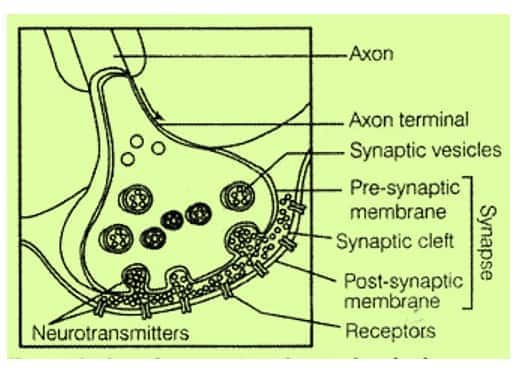
Question:2
Name the parts of the human forebrain, indicating their respective functions.
Answer:
The forebrain comprises the cerebrum, thalamus, and hypothalamus. Their functions are as follows:
Cerebrum:
It has motor and sensory functions.
Thalamus:
It helps in coordination and motor signalling.
Hypothalamus:
It helps in maintaining the body temperature and also the regulation of feelings like hunger and thirst.
Question:3
Explain the structure of the middle and internal ear with the help of a diagram.
Answer:
The structure of the human ear is divided into three parts- the external ear, the middle ear, and the internal ear.
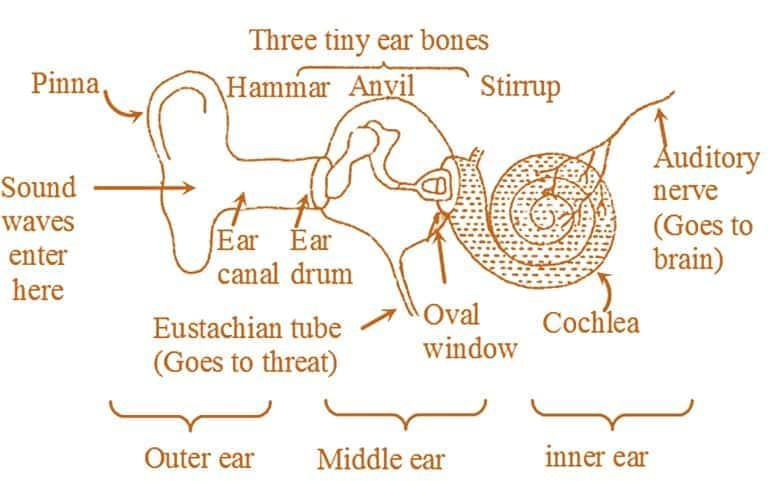
Structure of the Middle Ear: The middle ear is composed of three bones or ossicles- malleus, incus, and stapes. All three bones are attached to each other in a chain-like manner. The malleus is attached to the tympanic membrane, and the stapes is attached to a membrane of the cochlea called the oval window. The tympanic membrane is the one that separates the middle ear from the external ear. It is also called the eardrum. Not only that, but it also helps in catching the sound waves and transmitting them to the bony ossicles. From the bony ossicles, the waves are transferred to the inner ear. The eustachian tube connects the pharynx to the middle ear. tympanic membrane and bony ossicles. The tympanic membrane separates the middle ear from the external ear, and the middle ear is connected to the pharynx by the eustachian tube.
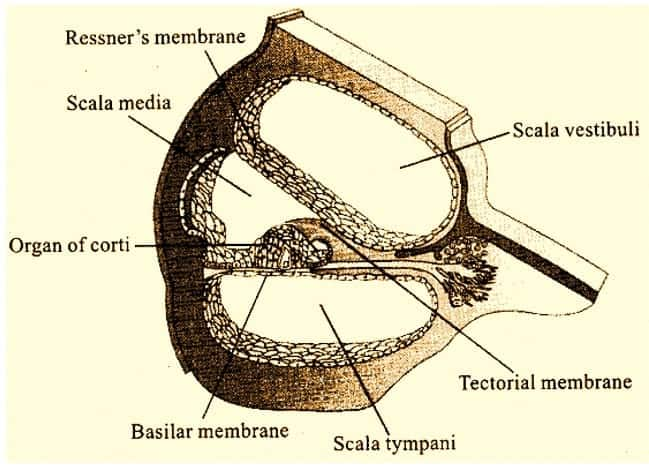
Structure of Inner Ear: The Inner ear is composed of a fluid-filled chamber called the labyrinth. It is divided into two parts- an outer bony labyrinth and an inner membranous labyrinth. The bony labyrinth consists of channels filled with a fluid called endolymph. The portion which is coiled in the labyrinth is the cochlea. The cochlea consists of two large ear canals- the upper vestibular canal and the lower vestibular canal. The two canals are separated by a cochlear duct. Semi-circular canals help in maintaining balance and posture of the body, and the cochlea helps in sending audio signals to the brain.
Access Answers to the NCERT Exemplar Class 11 Biology Solutions Chapter 21 (Short Questions)
Question:1
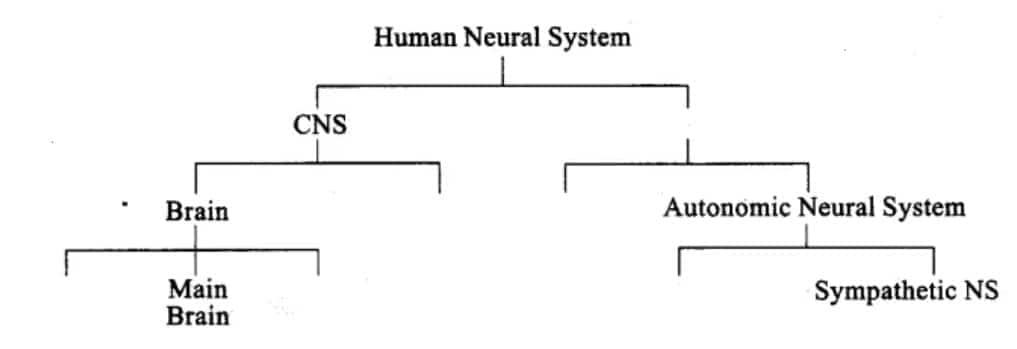
Answer:
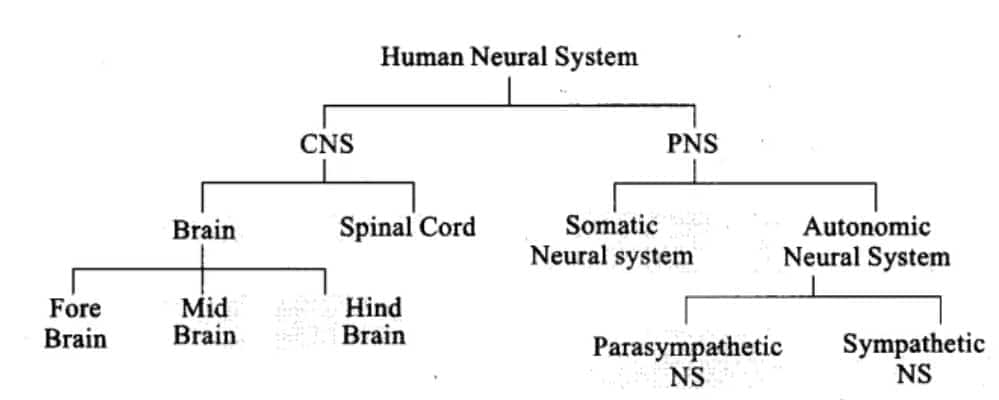
Question:2
What is the difference between electrical transmission and chemical transmission?
Answer:
Electrical transmission | Chemical transmission |
(i) Transmission takes place in the form of electric potential. | (i) Transmission takes place through chemicals. |
(ii) It transmits the signals in the neural system. | (ii) It transmits the signals in the hormonal system. |
(iii) It transmits faster. | (iii) It transmits more slowly. |
Question:3
Answer:
The brain is the controlling and command center, just like the CPU (central processing unit) in a computer system.
The sense organs are like the input devices of a computer system.
Eyes and ears can be related to a web camera, scanner, and headphones.
Nerves are just like the cable wires in a computer.
The responses of the body are like the output material of the computer.
Question:4
If someone receives a blow on the back of the neck, what would be the effect on the person's CNS?
Answer:
A blow on the back of the neck can cause serious damage to the medulla oblongata and the spinal cord, which in turn can cause serious problems in the normal functioning of the respiratory, cardiovascular, and gastric systems. It can also cause paralysis.
Question:5
What is the function described to the Eustachian tube?
Answer:
The eustachian tube helps in equalizing pressures on both sides of the eardrum, and it is also involved in the reception and transmission of sound waves into the internal ear.
Question:6
Label the following parts in the given diagram using arrows.
(a) Aqueous chamber
(b) Cornea
(c) Lens
(d) Retina
(e) Vitreous chamber
(f) Blind spot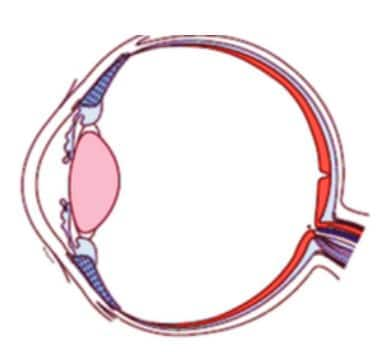
Answer:

NCERT Exemplar for Chapter 21 Neural Control and Coordination (Very Short Answer Type Questions)
Question:1
Answer:
Dendrites, Cell body, Axon, Axon terminal, Synaptic knob.
Question:2
Comment on the role of the ear in maintaining the balance of the body and posture.
Answer:
The vestibular apparatus present in the internal ear consists of the semi-circular canals and otolith. The semi-circular canals send signals to the brain in order to maintain balance and posture of the body.
Question:3
Which cells of the retina enable us to see coloured objects around us?
Answer:
Cone cells
Question:4
Answer:
External auditory canal, Eardrum, Malleus, Incus, Stapes, Cochlea, Cochlear nerve.
Question:5
Answer:

Question:6
Name the structures involved in the protection of the brain.
Answer:
The skull and Cerebrospinal Fluid (CSF).
Question:7
Answer:
The limbic system and hypothalamus is related to emotions.
Question:8
What do grey and white matter in the brain represent?
Answer:
The outer region of the cerebrum is composed of grey matter, which is also called the cerebral cortex. The grey matter represents the high concentration of cell bodies of the neuron. The inner region of the cerebrum is composed of white matter, which is also called the cerebral medulla. The white matter represents the high concentration of axons, which gives it a lighter appearance. Hence, the medulla is lighter in color and is called white matter.
Question:9
Where is the hunger center located in human brain?
Answer:
The hunger center is located in the Hypothalamus in the human brain.
Question:10
Which sensory organ is involved in vertigo (sensation of oneself or objects spinning around)?
Answer:
Ears: semi-circular canals in the internal ears are involved in the sense of vertigo.
Question:11
Answer:
Semi-circular canal
Question:12
Complete the statement by choosing the appropriate match among the following-
(a) Resting potential | (i) chemicals involved in the transmission of impulses at synapses. |
(b) Nerve impulse | (ii) Gap between the pre-synaptic and post-synaptic neurons |
(c) Synaptic cleft | (iii) electrical potential difference across the resting neural membrane |
(d) Neurotransmitters | (iv) an electrical wave-like response of a neuron to a stimulation. |
Answer:
(a)-(iii)
(b)-(iv)
(c)-(ii)
(d)-(i)
Also, check the NCERT Books and the NCERT Syllabus here
Approach to Solve Questions of NCERT Exemplar Class 11 Biology Solutions Chapter 21
Breaking down complex topics like neurons, synapses, and brain functions into simple parts makes it easier to understand and remember. Drawing diagrams, memorising sequences like nerve impulse transmission, and practising application-based questions help in answering both straightforward and tricky questions confidently.
Read the Neural Control and Coordination Class 11 NCERT Exemplar carefully to understand neuron structure, synapse, and brain parts.
Practice labelled diagrams of neurons, synapses, the brain, and sense organs.
Memorise the steps of nerve impulse transmission and the reflex arc.
Understand the differences between the sympathetic and parasympathetic nervous systems.
Solve all NCERT and Exemplar questions, focusing on reasoning and application.
Also, read the NCERT Solution subject-wise
Important Topic of Neural Control and Coordination Class 11 NCERT Exemplar
Below are the important topics from the chapter that students can go through to help them in the CBSE board exams, as well as other entrance exams:
- Structure and Function of a Neuron
- Nerve Impulse Transmission
- Synapse and Neurotransmitters
- Central and Peripheral Nervous System
- Reflex Action and Reflex Arc
- Sense Organs (Eye, Ear)
- Brain Structure and Functions
- Sympathetic and Parasympathetic Systems
- Neuromuscular Junction and Excitation–Contraction Coupling
- Ion Channel Types and Gating Mechanisms
NCERT Exemplar Class 11 Solutions
Advantages of NCERT Exemplar Class 11 Biology Chapter 21 Solutions
The Neural Control and Coordination chapter explains how the nervous system controls body functions through neurons, synapses, and neural impulses. Solving exemplar questions offers several advantages to students, some of which are mentioned below:
- NCERT Exemplar Class 11 Biology Chapter 21 Solutions gives a strong understanding of the structure of neurons, synaptic transmission, and conduction of nerve impulses.
- These questions improve the ability to answer diagram-based questions based on parts of the brain, reflex arcs, and neural pathways.
- Students will learn how to write answers in the correct format in the exam, improving scores in both school exams and competitive exams like NEET.
- Regular practice will increase the visual memory and better retention of concepts, which boosts confidence in solving conceptual and application-based questions.
Important Question of Neural Control and Coordination Class 11 NCERT Exemplar
Neural Control and Coordination is an important chapter for NEET as it explains how the nervous system functions, including nerve impulse transmission, reflexes, and sense organs. Practising previous years’ questions helps students focus on key concepts and understand the type of questions frequently asked in exams.
Q1. Chemicals released at the synaptic junction are called:
A. Hormones
B. Neurotransmitters
C. Cerebrospinal fluid
D. Lymph
Answer:
Neurotransmitters are the chemicals released at the synaptic junction. They are stored in synaptic vesicles in the presynaptic neuron and are released into the synaptic cleft to transmit nerve impulses to the postsynaptic neuron, ensuring communication between neurons .
Hence, the correct option is B. Neurotransmitters.
Must Read NCERT Notes subject-wise
NCERT Exemplar Class 11 Biology Solutions Chapter Wise
The NCERT exemplar chapter-wise solutions for class 11 biology are given below-
Frequently Asked Questions (FAQs)
Neural control and coordination refer to the processes by which the nervous system and endocrine system work together to regulate and integrate the activities of different organs, ensuring the body functions in a synchronised and efficient manner.
The human nervous system is divided into:
- Central Nervous System (CNS): Consists of the brain and spinal cord, responsible for processing and controlling information.
- Peripheral Nervous System (PNS): Comprises cranial and spinal nerves connecting the CNS to the rest of the body, and is further divided into the somatic and autonomic nervous systems (the latter includes sympathetic and parasympathetic divisions)
A neuron has a cell body (soma), dendrites (receive signals), and an axon (transmits signals). Nerve impulses are transmitted through changes in membrane potential (resting potential, action potential) and pass between neurons via synapses using neurotransmitters.
A reflex action is an automatic, involuntary response to a stimulus, mediated by the nervous system. The reflex arc is the pathway followed by nerve impulses during a reflex action, involving at least one sensory (afferent) neuron, one interneuron (in the CNS), and one motor (efferent) neuron.
The neural system provides rapid, point-to-point coordination through electrical impulses and neurotransmitters, while the endocrine system coordinates body functions more slowly using hormones released into the bloodstream for chemical integration.
Sensory Neurons: Transmit impulses from sensory organs to the CNS
Motor Neurons: Carry commands from the CNS to muscles/glands
Interneurons: Connect sensory and motor neurons within the CNS
Voluntary actions (e.g., walking) are controlled by the cerebrum
Involuntary actions (e.g., heartbeat) are regulated by the medulla oblongata and autonomic nervous system
Cerebrum: Controls thinking, memory, voluntary movements, and sensory perception
Cerebellum: Maintains posture, balance, and coordination of movements
CNS: Composed of the brain and spinal cord, processes information
PNS: Comprises nerves outside the CNS, transmitting signals between the CNS and the body
Reflex actions are automatic and quick responses to stimuli, controlled by the spinal cord through a reflex arc (e.g., pulling your hand away from a hot object).
Courses After 12th
Applications for Admissions are open.
As per latest syllabus. Physics formulas, equations, & laws of class 11 & 12th chapters
JEE Main Important Chemistry formulas
Get nowAs per latest syllabus. Chemistry formulas, equations, & laws of class 11 & 12th chapters
JEE Main high scoring chapters and topics
Get nowAs per latest 2024 syllabus. Study 40% syllabus and score upto 100% marks in JEE
JEE Main Important Mathematics Formulas
Get nowAs per latest syllabus. Maths formulas, equations, & theorems of class 11 & 12th chapters
